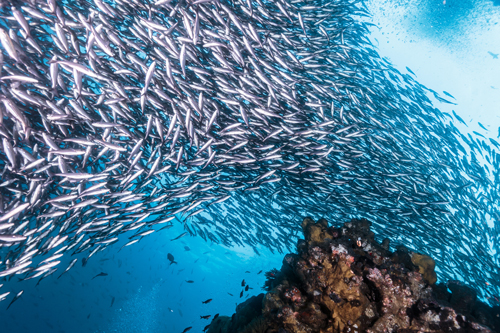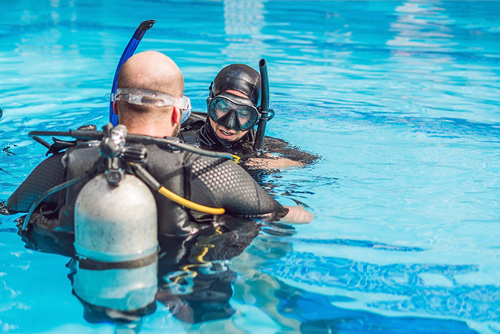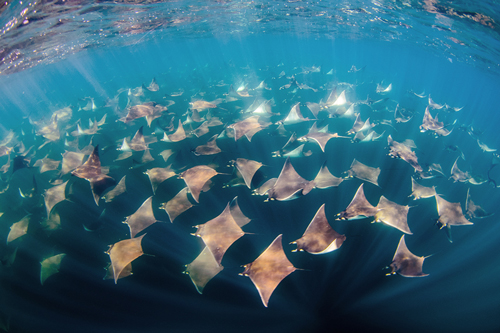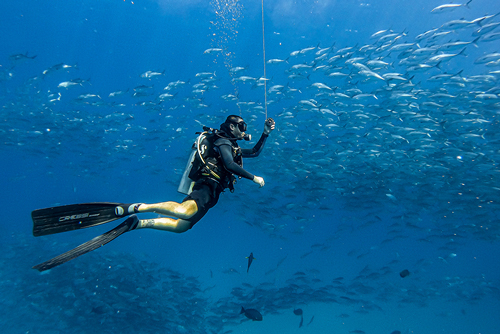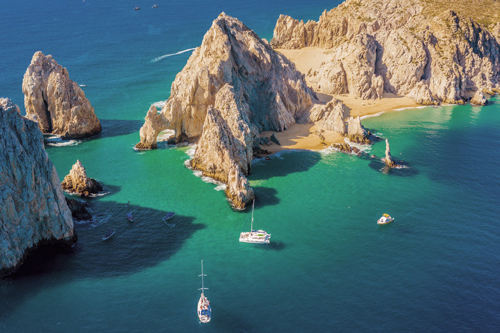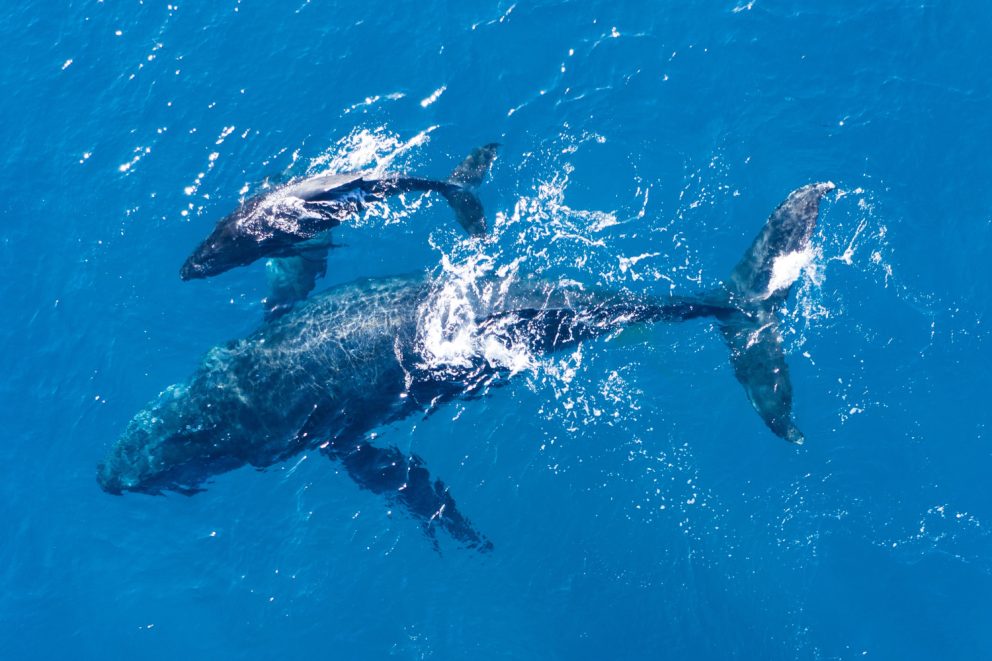Stunning animals, a dream for every wildlife lover, the humpback whales are an amazing photography subject and of course a breathtaking encounter for divers and snorkelers alike.
Visiting Cabo San Lucas is a must for any cetacean enthusiast as it’s one of the best places in Mexico to watch the Humpback whale. Starting from December this iconic whale species of Baja California can be seen along the coast of Los Cabos during their annual migration through the Pacific.
Would you want to know more about whale watching and the Humpback Whales of Cabo San Lucas? Just keep reading!
Table of Contents :
The Humpback Whale (Megaptera Novaeangliae)
Species description : What are humpback whales?
Humpback whale (Megaptera novaeangliae) is a species of cetaceans.
They are not fish but mammals, or more specifically cetaceans. They need to come up to the surface to breathe, just like dolphins, narwhals or sea lions.
They are one of the largest animals on earth, humpback whale adults range in length from 45 to 55 feet and weigh up to 35 metric tons.
The humpback whale gets its common name from the distinctive hump and the fact that they curving their backs when diving. They have a unique body shape, with particularly long pectoral fins, tubercles on their heads, a short dorsal fin and the tail fluke with a jagged trailing edge.
Humpback Whale quick fact
- Common name: Humpback whale
- Scientific name: Megaptera Novaeangliae
- Length: 45 to 56 feet (13 to 16 meters)
- Weight: 30 metric tons (30,000 kg)
- Lifespan: 45 – 50 years
Source : National Geographic , Britannica
Humpback Whale identification
Help the biologist community to collect data and identify whales around Cabo San Lucas, by becoming a citizen scientist : Take a picture of the tail fluke during your whale watching tour, and upload the picture through a database to identify the whale encountered or maybe identify a new whale never registered before !
Read more on: happywhale.com

Behavior
Humpback whales are extremely social animals. Large aggregations form during feeding and during sexual competition, while they are normally sighted in smaller groups or pods in other occasions.
They generally move two or three at a time – mother, calf and escort – during migrations, but can be seen in larger groups or full families during the breeding season.
Whale watching around Cabo San Lucas is a very interesting experience, humpback whales can be very active on the surface, resting horizontally, performing aerial jumps – called breaching – and lobtailing, also known as slapping with their fins and fluke.
Diet & Eating habits
As all cetaceans, they are carnivores, they feed on krill, plankton and small fish.
Fun Fact! A single humpback whale can eat around 3,000 lb. food per day!
Distribution and Migration
Humpback whales can be found worldwide, in all oceans, except for the High Arctic and some enclosed seas. They are generally coastal and tend to gather within continental shelves.
They go on vast migrations between feeding and breeding season – feeding in summer, breeding in winter – traveling up to 5,000 miles in one direction.
Different population groups – there are about a dozen worldwide – have their own migratory route. Here in Cabo, and in general in the Mexican Pacific coast, we get to see the North Pacific Humpback whales.

As other species, the North Pacific Humpback Whale follows a very specific migration path: they feed in the colder waters of the Northern Pacific, and migrate to the warmer waters of Hawaii or the Mexican coast of Baja California to give birth.
Here is why we often have the chance to see mothers and calves migrating along our stunning coasts!
Reproduction
Breeding season takes place in winter. A humpback whale gestation lasts 11.5 months, and females reproduce every two years.
Mothers typically give birth to a single calf, nursing it for about a year. Sexual maturity is reached at 5-10 years of age.
Conservation status
Luckily, humpback whales are no longer listed as a vulnerable species since 2008, which is a good step in the direction of their preservation. They are also described as least-concern species in the IUCN Red List.
However, men still pose several threats to these peaceful, beautiful animals. Numerous humpback whales’ incidents have been recorded, involving fishing nets, entanglements, boat collisions and of course, sadly, whaling and whale hunting.
While looking for a humpback whale in Cabo San Lucas, if it happens that you encounter a whale caught in a fishing net or in danger, contact the local authorities (Navy, Harbor Master, CONANP). More info on RABEN
Humpback Whale song and Vocalization
Humpback whales are famous for their unique vocalizations. While both males and females are able to vocalize, only males produce those long – up to 33 minutes! – loud, complex “songs” for which this whale species is so famous.
Why do whales sing?
The scope of these languages is not completely clear yet, but speculations include establishing social status and dominance, mating invitation, echolocation, and so on.
Divers joining us in Cabo San Lucas will often hear them singing underwater during our whale season!

What are the best months to see humpback whales in Cabo?
If you are wondering when you can see humpback whales in Los Cabos, we recommend you to visit Cabo San Lucas between the end of November when the first whale starts to appear to the beginning of May when the whale migration ends.
Cabo San Lucas whale season
The official whale season in Cabo San Lucas is actually from December 15th until April 15th.
The best months to see whales in Los Cabos are January, February and March, but the season lasts longer. These months offer higher chances to spot whale In large numbers.
As Baja California is a migratory route for more species of whales, such as Humpback, Sperm and Blue Whales, in these peak months, seeing a whale during the surface interval, while snorkeling and whale watching with us is almost guaranteed!
What’s the best time to visit Cabo San Lucas?

Enjoy a private whale watching tour from Los Cabos
Humpback whales are gorgeous, elegant animals. Even if you are not a diver or a snorkeler, here at Cabo Private Guide anyone can join a magical whale watching on a private boat! From the comfort of a luxury vessel – either a private yacht or a speed boat, it’s your choice! – you can observe one of the biggest animals on the planet, often along with their adorable calves.
It truly is an activity for all: adventure seekers, youngsters and elderly people, solo travelers, families with children, nature lovers, groups of friends, etc.
Choosing Cabo Private Guide for your whale watching tour means not only escaping crowded boats, but also having a deeper connection with the wild life and a higher chance of a closer and more personalized encounter with these fantastic animals.
Our crew, knowledgeable, experienced and passionate about marine life and ocean conservation, will be sure to teach you all you want to know – and more – about these glorious animals.
Keep reading
Want to know more about marine life in Baja California and Cabo San Lucas ? :


